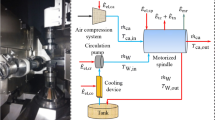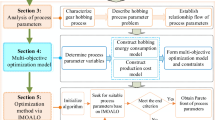Abstract
The thermal accumulation problem of the dry hobbing machine spindles is quite serious and is an essential reason for gear machining accuracy. Hence, this study focuses on thermal accumulation modeling and optimization for dry hobbing machine spindles. Firstly, the thermal accumulation characteristics of the hob spindle and workbench spindle in dry hobbing machine are clarified, and the effect mechanism of thermal accumulation on the machine spindles deformation is revealed. Then, the thermal accumulation models for the hob spindle and workbench spindle in dry hobbing machine are established, respectively, and the characteristic parameters of the thermal accumulation models are quantitatively analyzed. Finally, a multi-objective optimization approach for the process parameters considering minimum thermal accumulation in dry hobbing machine spindles is proposed, and a case study is conducted. The experimental results indicate that the thermal accumulation of the hob spindle and workbench spindle is reduced by 11.17% and 19.3%, respectively; the hobbing efficiency is increased by 8.22% as well as effectively reducing the average temperature of the machine spindles and controlling the gear’s M-value, which proves the effectiveness of proposed approach.












Similar content being viewed by others
Data availability
The datasets used or analyzed during the current study are available from the corresponding author on reasonable request.
References
Pawanr S, Garg G, Routroy S (2022) A novel approach to model the energy consumption of machine tools for machining cylindrical parts. J Manuf Process 84:28–42
Liu C, He Y, Wang Y, Li Y, Wang S, Wang L, Wang Y (2020) Effects of process parameters on cutting temperature in dry machining of ball screw. ISA Trans 101:493–502
Gupta K, Laubscher R, Davim J, Jain N (2016) Recent developments in sustainable manufacturing of gears: a review. J Clean Prod 112:3320–3330
Sreejith P, Ngoi B (2000) Dry machining: Machining of the future. J Mater Process Technol 101:287–291
Li Z, Wang B, Zhu B, Wang Q, Zhu W (2022) Thermal error modeling of electrical spindle based on optimised ELM with marine predator algorithm. Case Stud Thermal Eng 38:102326
Bitar-Nehme E, Mayer J (2018) Modelling and compensation of dominant thermally induced geometric errors using rotary axes’ power consumption. CIRP Ann 67:547–550
Zhang C, Gao F, Yan L (2017) Thermal error characteristic analysis and modeling for machine tools due to time-varying environmental temperature. Precis Eng 47:231–238
Zhao Z, Wang Y, Wang Z, Liu J (2019) Thermal analysis for the large precision EDM machine tool considering the spark energy during long-time processing. J Mech Sci Technol 33:773–782
Yao X, Du Z, Ge G, Yang J (2020) Dynamic temperature gradient and unfalsified control approach for machine tool thermal error compensation. J Mech Sci Technol 34:319–331
Feng W, Li Z, Gu Q, Yang J (2015) Thermally induced positioning error modelling and compensation based on thermal characteristic analysis. Int J Mach Tools Manuf 93:26–36
Wei X, Ye H, Miao E, Pan Q (2022) Thermal error modeling and compensation based on Gaussian process regression for CNC machine tools. Precis Eng 77:65–76
Narendra Reddy T, Shanmugaraj V, Vinod P, Gopi Krishna S (2020) Real-time thermal error compensation strategy for precision machine tools. Mater Today: Proc 22:2386–2396
Zhu L, Cao H, Zeng D, Yang X, Li B (2017) Multi-variable driving thermal energy control model of dry hobbing machine tool. Int J Adv Manuf Technol 92:259–275
Kadashevich I, Beutner M, Karpuschewski B, Halle T (2015) A novel simulation approach to determine thermally induced geometric deviations in dry gear hobbing. Procedia CIRP 31:483–488
Li X, Yang Y, Zou Z, Liu Z, Wang L, Tang Q (2019) Critical study on the thermal-structural characteristics of worktable assembly of a dry hobbing machine. Int J Adv Manuf Technol 100:179–188
Yang X, Cao H, Li B, Jafar S, Zhu L (2018) A thermal energy balance optimisation model of cutting space enabling environmentally benign dry hobbing. J Clean Prod 172:2323–2335
Li B, Cao H, Yang X, Jafar S, Zeng D (2018) Thermal energy balance control model of motorised spindle system enabling high-speed dry hobbing process. J Manuf Process 35:29–39
Yang X, Zeng L, Chen P, Du Y, Li B (2022) Complex characteristics and multi-dimensional control strategies of heat flow in dry gear hobbing machines. China Mech Eng 33:623–629
Yang X, Chen P (2022) Heat transfer enhancement strategies for eco-friendly dry hobbing considering the heat exchange capacity of chips. Case Stud Therm Eng 29:101716
Li B, Yang X, Du Y, He L (2022) Optimisation of chip repose angle in dry hobbing machine considering minimum thermal accumulation on workbench. Int J Adv Manuf Technol 122:1821–1833
Incropera F, Dewitt D, Bergman T, Lavine A (2007) Fundamentals of heat and mass transfer. John Wiley & Sons Inc
Li Y, Zhou S, Liu J, Tong J, Dang J, Yang F, Ouyang M (2023) Multi-objective optimisation of the Atkinson cycle gasoline engine using NSGA III coupled with support vector machine and back-propagation algorithm. Energy 262:125262
Li Z, Luo Z, Wang Y, Fan G, Zhang J (2022) Suitability evaluation system for the shallow geothermal energy implementation in region by entropy weight method and TOPSIS method. Renew Energy 184:564–576
Funding
This work was supported by the Key Projects of Strategic Scientific and Technological Innovation Cooperation of National Key R&D Program of China (Grant No. 2020YFE0201000), the National Natural Science Foundation of China (NSFC) (Grant No. 51905059), the China Postdoctoral Science Foundation (Grant No. 2021M693748), the Innovative Research Group of Universities in Chongqing (Grant No. CXQT21024), the Special Funding for Postdoctoral Research Projects in Chongqing (Grant No. 2021XM2020), and the Graduate Research Innovation Project (Grant No. CYS22621).
Author information
Authors and Affiliations
Contributions
Bo Li contributed to the conception of the study; Bo Li, Yanbin Du, and Xiao Yang contributed significantly to analysis and manuscript preparation; Guohua He and Lang He helped perform the analysis with constructive discussions.
Corresponding author
Ethics declarations
Ethical approval
Not applicable.
Consent to participate
Not applicable.
Consent for publication
Yes.
Competing interests
The authors declare no competing interests.
Additional information
Publisher's note
Springer Nature remains neutral with regard to jurisdictional claims in published maps and institutional affiliations.
Rights and permissions
Springer Nature or its licensor (e.g. a society or other partner) holds exclusive rights to this article under a publishing agreement with the author(s) or other rightsholder(s); author self-archiving of the accepted manuscript version of this article is solely governed by the terms of such publishing agreement and applicable law.
About this article
Cite this article
Li, B., Du, Y., Yang, X. et al. Multi-objective process parameter optimization considering minimum thermal accumulation on spindles of dry hobbing machine. Int J Adv Manuf Technol 126, 4337–4351 (2023). https://doi.org/10.1007/s00170-023-11371-8
Received:
Accepted:
Published:
Issue Date:
DOI: https://doi.org/10.1007/s00170-023-11371-8




